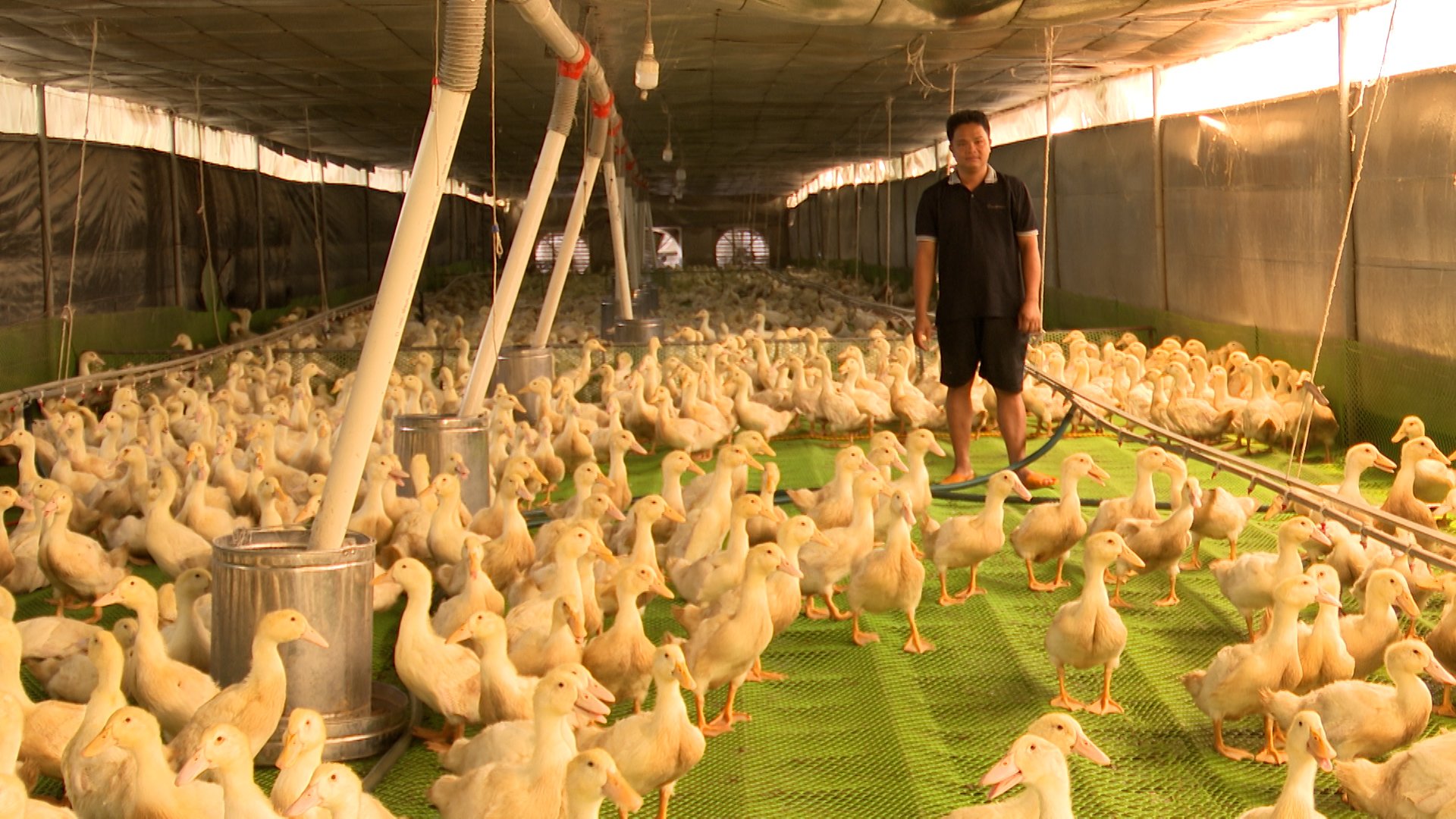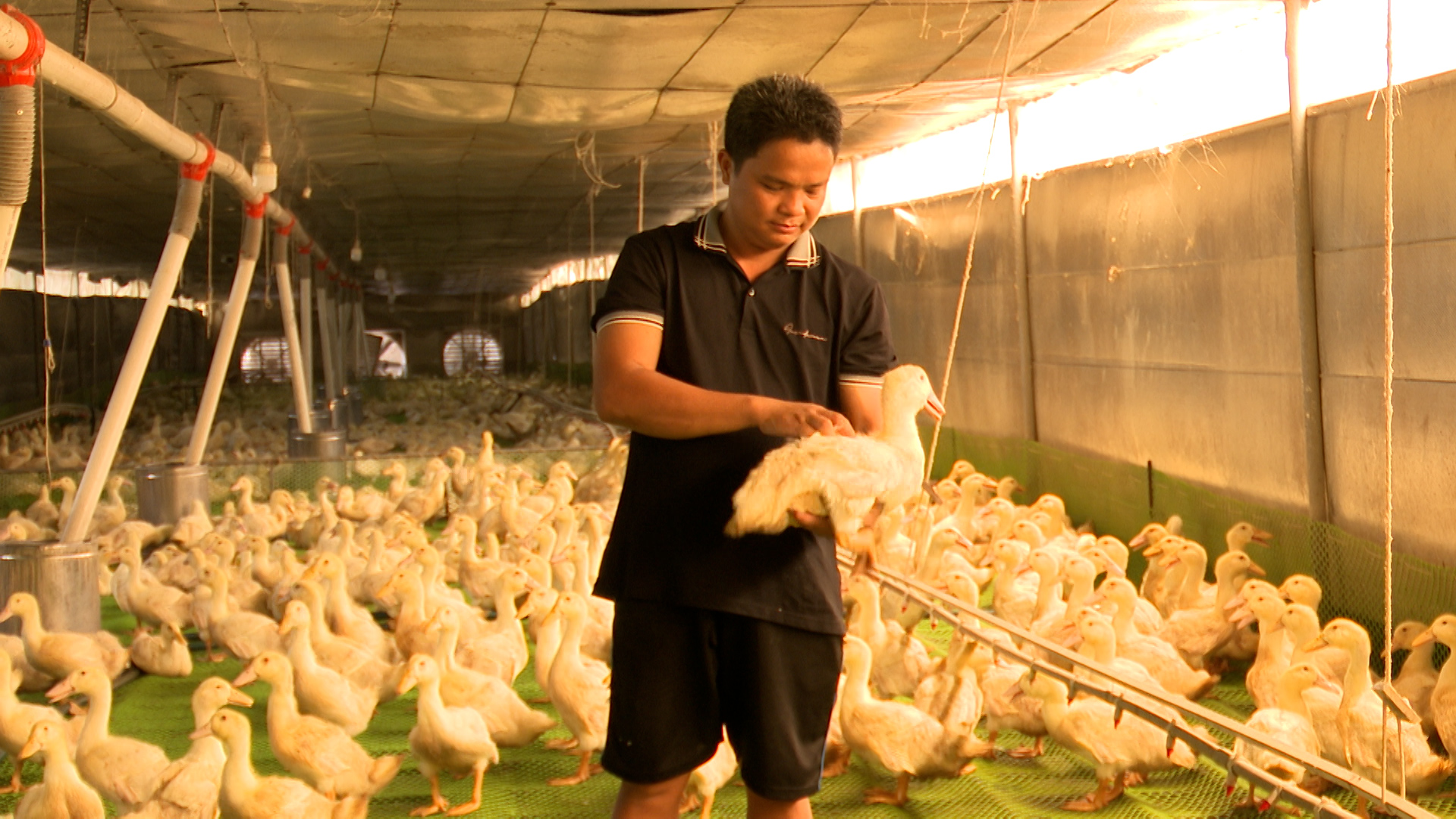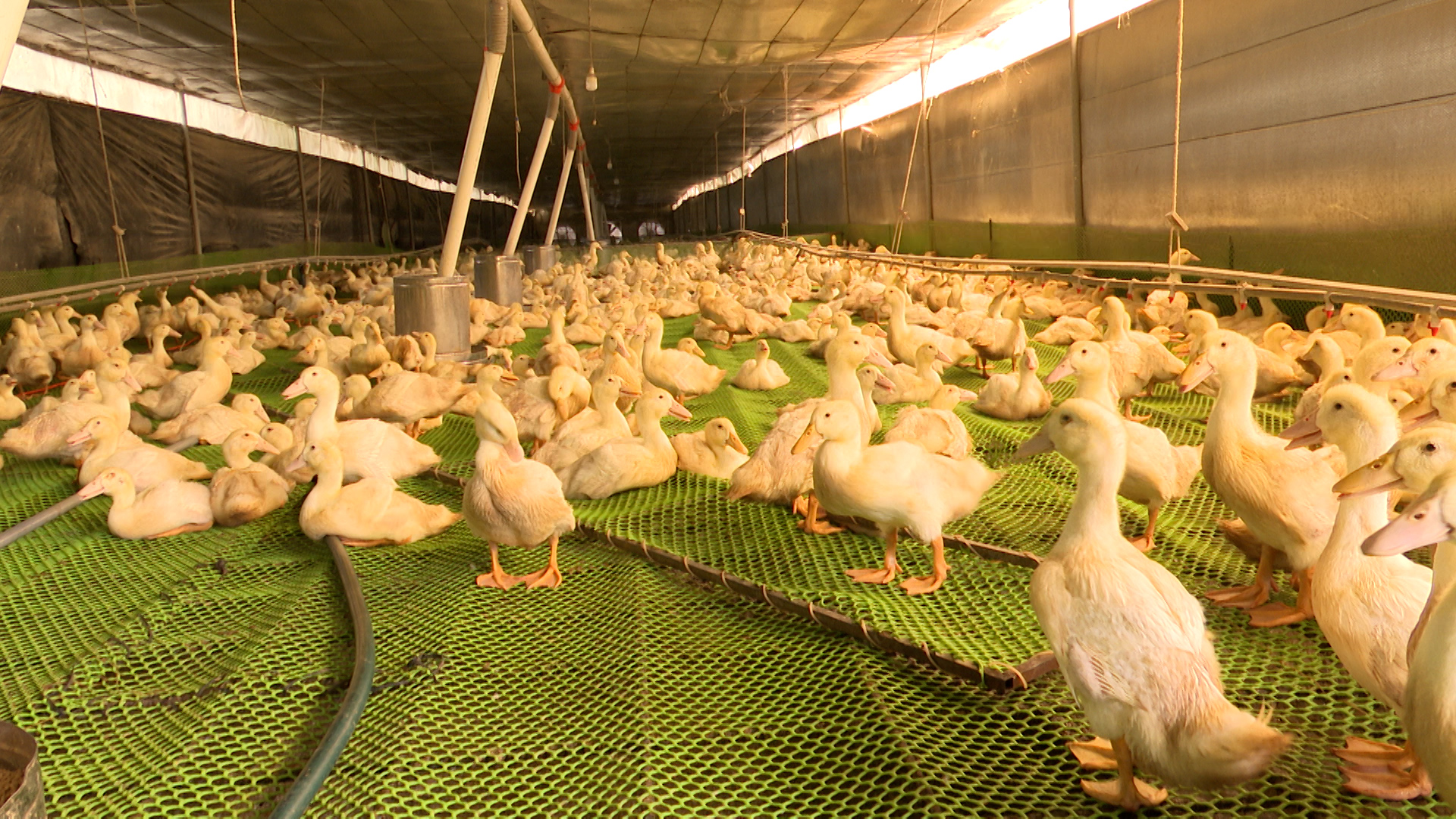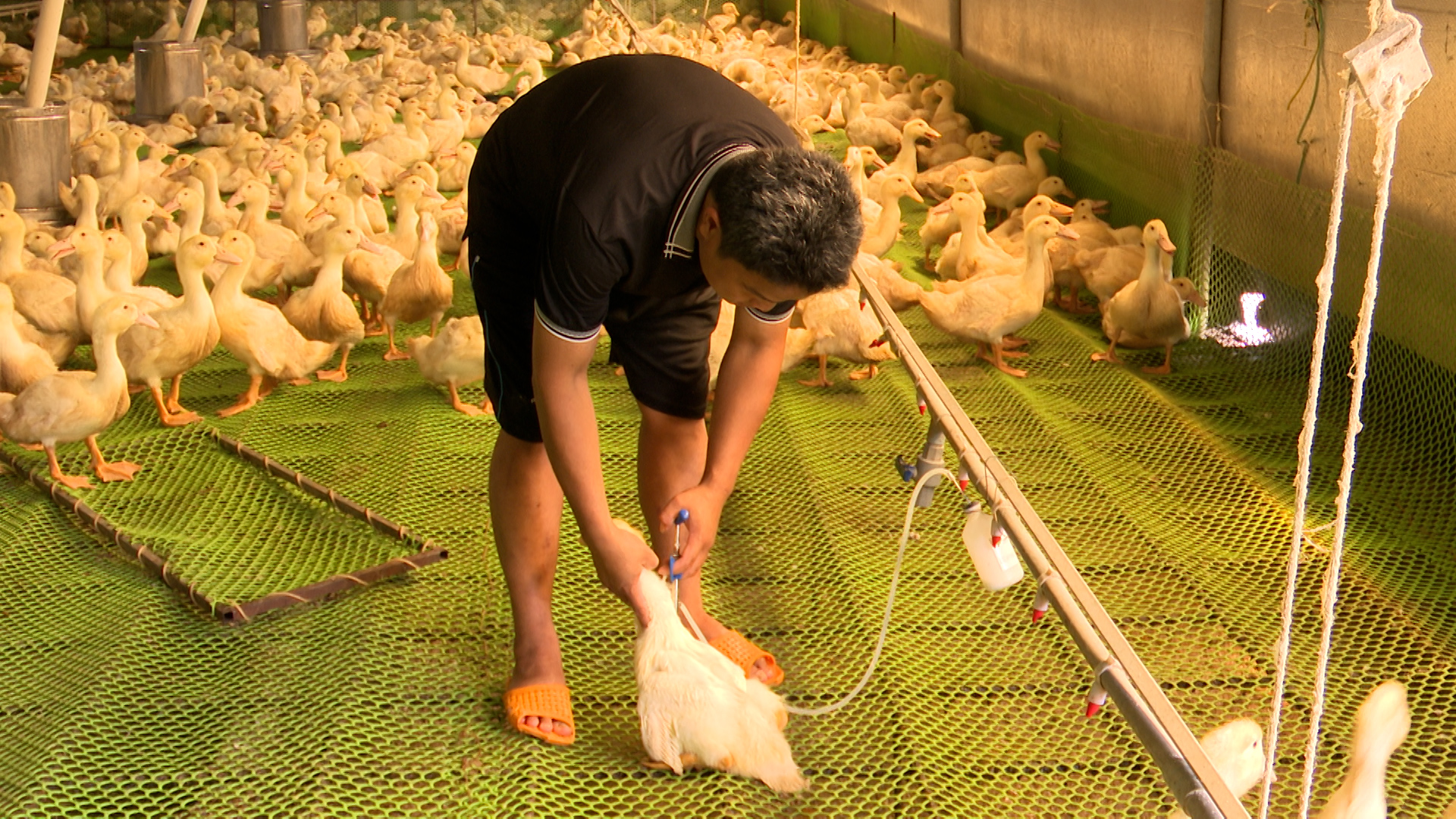June 5, 2025 | 21:05 GMT +7
June 5, 2025 | 21:05 GMT +7
Hotline: 0913.378.918
June 5, 2025 | 21:05 GMT +7
Hotline: 0913.378.918

Mr. Thanh's cold duck farm Tan Binh hamlet, An Thai commune. Photo: Tran Trung.
Duck farming traditionally involves the prevailing imagery of riverine lowlands adorned with extensive rice paddies and the graceful flight of herons. However, a visit to the sprawling rubber plantations in Binh Duong province reveals a surprising departure from this traditional notion, which is the practice of high-tech cold duck farming on elevated platforms.
Accompanied by a representative of the Farmers' Association in An Thai commune, Phu Giao district, we visited an innovative high-tech cold duck farming model where Mr. Pham Ngoc Thanh raises nearly 20,000 ducks in Tan Binh hamlet. The most striking feature of the farm is the meticulous arrangement of duck enclosures, which is entirely devoid of noxious odors. Within each enclosure, the plastic mesh floor is elevated to a height of approximately 50 centimeters above ground level, providing the ducks with an elevated, well-ventilated, and hygienic living environment.
The enclosure ceilings feature thermal insulation, and water spray fans on either side to maintain a temperature range between 20 and 22 degrees Celsius. Additionally, the automated drinking water system and feeding troughs alleviate the labor and time required for duck feeding by the workers.

The cold duck farming model minimizes disease risks and yields high economic efficiency. Photo: Tran Trung.
With a healthy 3-kilogram duck in his hand, Mr. Thanh shared that Phu Giao district has been regarded as the hub for pig, cattle, and poultry farming in Binh Duong province. Accordingly, the majority of local residents have extensive experience in production.
After learning that duck farming is simple to raise, efficient, and feature similar disease prevention methods to other poultry production, Mr. Thanh decided to experiment with this livestock in 2012 to explore new avenues for his family's economic development as well as the local community.
He initially utilized the available rubber plantation area and established a duck farming model on dry land under the shade of rubber trees. During the early stages, the model's efficiency was relatively high due to the low stocking density.
However, as the number of livestock grew, the management of feed and disease control became challenging, and initial losses were substantial. After researching successful cold duck farming models, Mr. Thanh began to shift towards high-tech duck farming by 2018.

Ducks living in the controlled environment of a cold farm have limited contact with the outside world, including humans, which helps to minimize the risk of disease and promotes their healthy growth. Photo: Tran Trung.
"The advanced technology duck farming facility is fully equipped with flooring, refrigeration, a biogas pit to process waste for heating, and an automated feeding system controlled through a mobile app.
The total investment for 1000 ducks amounts to approximately 200 million VND, which can be utilized over a period of five to seven years. In return, the ducks are provided with fully automated feeding, limited exposure to external elements including humans, thereby minimizing the risk of diseases, and ensuring uniform growth," shared Mr. Pham Ngoc Thanh.

Mr. Thanh actively implementing disease prevention measures for his duck herd. Photo: Tran Trung.
In addition to the application of advanced technology, Mr. Thanh highlighted that proactive disease prevention plays a decisive role in the success of this model. According to him, the correct and comprehensive vaccination of the ducks is a necessity.
In contrast to the traditional duck farming model, the pens must undergo detoxification and disinfection fifteen days before the ducks are raised. Additionally, ducklings are raised for five days before being released into the elevated floor houses. In order to enhance the meat quality, ducks require play areas, regular rests, controlled feeding, and vaccinations against various diseases including avian influenza, E. coli, and internal organ fungi between 14 and 30 days old.
"Ducks are both a waterfowl and a poultry, so the most concerning diseases include avian influenza, E. coli, internal organ fungi, and several others. However, ducks raised on an elevated floor in a closed, temperature- and humidity-controlled environment are unaffected by weather condition. As a result, they only need comprehensive vaccinations to control diseases. Ducks raised on a elevated mesh floor are more muscularly active, resulting in high-quality, fragrant, and firm meat with a high percentage of thigh and breast meat, which is favored by consumers," shared Mr. Pham Ngoc Thanh.
Following a three-year period of experimentation involving the raising of 1,000 ducks, the farm has since expanded its operations to encompass nearly 20,000 ducks. In stark contrast to traditional practices, where it necessitated between 52 and 55 days to raise a generation of ducks, coupled with an estimated consumption of approximately 300 bags of bran per 1,000 ducks per generation, the current approach has seen a notable reduction in the rearing period to 45 days. Furthermore, this modern method entails the consumption of 270 bags of bran per ducks after releasing. Subsequently, each duck can achieve an average weight of 3.5 kilograms, which is a substantial increase of 200 grams when compared to the traditional farming techniques. Considering the prevailing market dynamics with duck prices fluctuating within the range of 50,000 to 52,000 VND per kilogram, this model has consistently yielded significant profit for Mr. Thanh's family with each successive duck generation.

The Farmers' Association in An Thai Commune is actively promoting and expanding the cold duck farming model. Photo: Tran Trung.
According to the An Thai commune's Farmers' Association, the high-tech cold duck farming model has been an effective and innovative direction implemented by many local residents. The commune's Farmers' Association has collaborated with relevant agencies and the Economic Department of Phu Giao district to regularly organize scientific and technical transfer classes for farmers and association members.
"Mr. Thanh's model is one of the exemplary models in the commune. In addition to substantial profits, he has directly assisted five neighboring households by providing breeding stock and technical guidance to market access, thereby helping local residents improve their livelihoods.
The Farmers' Association will continue to encourage its members to participate in the model and call on relevant governments to provide technical support and funding to expand the model, contributing to the realization of the exemplary new rural model in accordance with the local Party Committee's resolution for the commune," emphasized Mr. Tran Phi Long, Chairman of An Thai commune's Farmers' Association.
Translated by Nguyen Hai Long

(VAN) Technology is redrawing the map of Vietnamese aquaculture: more modern, greener, and more sustainable.

(VAN) Novel process harnesses machine learning to reveal groups of genes that determine how efficiently plants use nitrogen.

(VAN) Several scientists and farmers are experimenting with soil treatment in some key durian-growing regions such as Cai Lay (Tien Giang), Dak Song, Gia Nghia, and Dak R’lap (Dak Nong).
/2025/05/25/4127-3-073637_820.jpg)
(VAN) Thanks to the promotion from an FAO-implemented project, vegetable production in greenhouses in Moc Chau has seen strong development, from 1.5 hectares in 2021 to nearly 50 hectares in 2024.

(VAN) FAO has recently supported USD 140,000 to implement the project 'Risk mitigation human-animal interface risks through disease control initiatives in pig farming.'

(VAN) The People's Committee of Tra Vinh province has approved an adjustment to the investment policy for the Green Hydrogen Plant project, increasing its area to approximately 52.76 hectares.
![Reducing emissions from rice fields: [2] Farmers’ commitment to the soil](https://t.ex-cdn.com/nongnghiepmoitruong.vn/608w/files/news/2025/05/05/dsc08881jpg-nongnghiep-140632.jpg)
(VAN) Clean rice cultivation model in Thuong Tan commune, Bac Tan Uyen district, is assisting local residents in achieving sustainable agriculture by substantially reducing costs, increasing productivity, and protecting the environment.